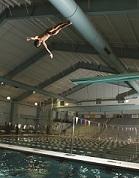
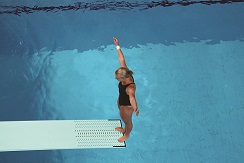
In response, facility operators have taken it upon themselves to understand the economic impact such events have on their communities. Believe it or not, this is a relatively new development in the swim industry, according to Dean Ekeren, national events director for USA Swimming.
“Historically, swimming has been governed by swim parents and not necessarily people who are involved with the pool year after year,” Ekeren says. “Now, we’re seeing more professional-level event managers running events. Over the past several years, hosts have gotten much more business-savvy than they used to be.”
One major indication of that savviness is the number of communities that now take advantage of revenue from hotel and restaurant taxes to recruit events sanctioned by USA Swimming, USA Diving, college conferences, state high school athletic associations and other organizations.
USA Swimming is working diligently with swim clubs and facility owners to educate them about their obligation to help the sport continue to grow, both locally and nationally.
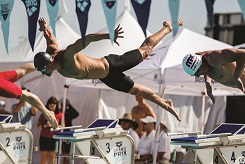
Swimming tends to garner most of the attention in aquatics, but following gold, silver and two bronze medals for U.S. divers at the 2012 Summer Olympics — including two medals in the new synchronized diving category — USA Diving reports strong interest from participants and potential hosts.
“In recent years, there has been an increased focus on synchronized diving both at USA Diving and with our international governing body FINA,” says Mikela Calabrese, national events manager for USA Diving. “In addition, more events have been added to the USA Diving calendar, [which] will cause a need for more facilities to be willing and able to host USA Diving events.”
Aquatics Advancements
Continual advances in technology and product design make keeping up with the state of the art a challenging (and costly) proposition. But, at least to a certain extent, doing so is necessary in order for a facility to contend in the bidding process.
Video boards, regardless of whether they have replay capability and are permanent or temporary, have become almost a necessity. They not only display lane assignments, race times, dive scores and other pertinent information but also allow event organizers to showcase corporate and local sponsors.
Diving, too, has moved on from manual scorecards held up by judges to the increased use of electronic score pads and scoring systems, with interfaces designed for scoreboards and video boards.
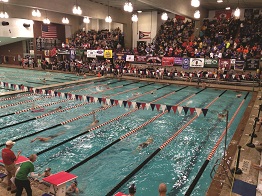
Air quality issues present another constant struggle for natatorium operators, who now place portable units around the deck that filter and recirculate air. “The problem we see is that aquatics facilities are still not designed for the type of loads you are looking at during a swimming competition,” Ekeren says. “They’re designed more for everyday use.”
Also on deck, traditionally flat starting blocks are being replaced by track-style blocks that come equipped with a removable “fin,” which allows a swimmer to push off with his or her back foot. More recently, a portable backstroke wedge — which hangs over the edge of the pool on which swimmers can rest their toes to prevent slipping on starts — was introduced at the 2014 Winter National Championships at the Greensboro (North Carolina) Aquatics Complex in December.
While that facility is one of the largest in the country, regularly attracting elite competitions, natatoriums of all ages and sizes across the United States are in the market to bolster their swimming and diving presence. Here are seven of those locales, and this is how they’re bringing in the events.
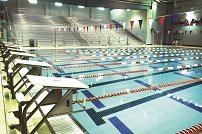
The C.T. Branin Natatorium in Canton, Ohio, built in 1976, and owned and operated by the Canton City School District, is considered one of the premier swimming facilities in the Midwest. With eight-lane 25-yard and 50-meter pools, a 14-foot diving well, two 1-meter diving boards and one 3-meter board, the facility can hold 2,400 spectators and has room for 1,000 swimmers on deck.
“The thing that is most awesome about our facility is the arena-style seating,” says Sam Seiple, the natatorium’s aquatics director. “There is bleacher seating on three sides of the pool, so you can imagine how exciting it gets in here. The noise level is amazing.”
The pool has hosted a variety of high-profile college, high school and club meets, and it’s typically booked solid from October to March. “We book a ton of rooms for the hotels,” Seiple says. “All the sales managers know about swimming because of this facility.”
The lack of a video board has cost C.T. Branin some events, acknowledges Tonja Marshall, director of sports tourism for the Canton/Stark County Convention & Visitors’ Bureau. But the natatorium, located adjacent to the Pro Football Hall of Fame, is one piece of a proposed “Hall of Fame Village” and could be included in a series of potential renovations. “That’s part of the conversation,” Marshall says.
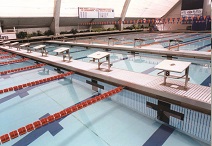
Like Canton, aquatics activities in Lubbock, Texas, revolve around one major facility: the popular Pete Ragus Aquatic Center, owned and operated by the Lubbock Independent School District. The eight-lane, 50-meter pool originally opened in 1997.
The facility hosted the USA Diving Spring Junior West National Championships in 2011, and recently bid on another regional USA Diving event. Chris Rohrer, sales manager for Lubbock Sports, claims the lack of space for a diving platform has hurt the facility. “That’s the one thing that I wish we had,” he says.
Of the 21 events USA Diving hosts every year, Calabrese says nine require a 10-meter platform. Regional championships, on the other hand, need only one 1-meter springboard and one 3-meter springboard. A platform gives a facility the opportunity to host more USA Diving events, and Rohrer knows that.
“A lot of new facilities are popping up, so we have to keep up with everybody else,” he says, adding that the spacious Pete Ragus Aquatic Center has undergone multiple renovations and that the school district’s staff has perfected the art of running a meet. “We have an older pool, so we promote how well we run events,” he says. “They are professional, clean and on time, with no surprises.”
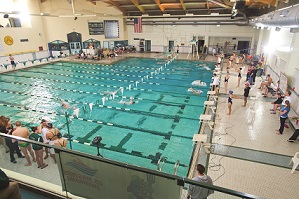
A diving platform has served the University of Missouri’s Mizzou Aquatic Center well, according to Megan McConachie, marketing and communications manager for the Columbia Convention and Visitors Bureau. “Mizzou has a well-performing diving team, so it actually attracts some extra attention to the facility and definitely helps as an additional feature,” she says.
Opened in 2005, the center offers a 50-meter pool with elevated spectator seating, a 10-meter diving platform and four springboards.
The facility hosted the discontinued USA Swimming-sanctioned Missouri Grand Prix and now is used primarily by university students and teams, “which makes it more difficult to find times when it is available,” McConachie says. “But when we can promote it, the facility is world-class, and it has a world-class reputation.”
Following the Trail of Victory
An example of an older facility keeping pace with contemporary demand can be found at the Steven C. O’Connell Center on the University of Florida campus in Gainesville. Opened in 1981 and the focus of several renovations, the aquatics component of the facility has hosted Southeastern Conference and NCAA championships, USA Swimming Junior National Championships, Junior Olympic championships and club events. The facility has two 1-meter diving boards and two 3-meter boards, as well as 5- and 10-meter platforms. Retractable bleachers can seat up to 1,200 spectators.
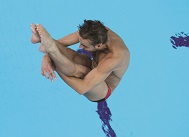 “It’s a world-class pool,” says Joleen Cacciatore, executive director of the Gainesville Sports Commission. “If you’re hosting an event here, you’re part of the history of the University of Florida, which includes several past and present Olympians who have trained here.”
“It’s a world-class pool,” says Joleen Cacciatore, executive director of the Gainesville Sports Commission. “If you’re hosting an event here, you’re part of the history of the University of Florida, which includes several past and present Olympians who have trained here.”
Considered one of the fastest pools in the world, the O’Connell Center has been home to Ryan Lochte and Dara Torres, who have combined to win 33 Olympic medals. The bottom of the pool slopes rapidly to significantly reduce wave action, and an extensive gutter system limits additional waves
Staying and Playing (Outside!) in Mesa
None of the nine (soon to be 10) aquatics facilities in Mesa, Arizona, have diving platforms; that would be too much of a liability for Mesa Public Schools, which runs all of the venues. Still, the pools are still plenty busy — especially Skyline Aquatics Center, which opened in 2011 with a 50-meter pool, and Kino Aquatic Center, featuring a 70-meter pool that opened in 2009. Collectively, the two facilities have hosted events sanctioned by USA Swimming, USA Diving, USA Water Polo and USA Synchro.
Additionally, Mesa is home to the annual Citrus Classic Winter Training and Swim Meet, which throughout last December and January welcomed 400 swimmers and divers from 15 colleges and universities in cold-weather states to train for several days. All participants are required to stay at Mesa hotels, says Josh Todd, sports sales manager for Visit Mesa, boosting the local economy while giving swimmers and divers an appealing alternative to being cooped up inside a natatorium. “Swimmers love swimming outdoors,” Todd says. “And we can provide that opportunity.”
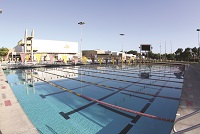
Bloomington and Normal, nestled almost smack-dab in the middle of Illinois, boast a combined population of about 130,000 and are home to two universities: Illinois State and Illinois Wesleyan. Both offer aquatics facilities that can accommodate smaller events.
Illinois Wesleyan’s Fort Natatorium has an eight-lane, 25-yard pool and seating for 250 spectators, while Illinois State’s Horton Pool is smaller, with six lanes and less seating. “We have a great relationship with both universities and their athletic departments,” says Matt Hawkins, sports marketing manager for the Bloomington-Normal Area Convention & Visitors Bureau. “So we are interested in hosting more swimming events for organizations that are interested in us.”
Working Well with the NGB
The Fresno-Clovis, California, area is similar to Bloomington-Normal in that it is located in the middle of state. That prime location is one of several reasons why the Clovis Unified School District, on May 22 and 23, will host the first-ever California Interscholastic Federation’s Swimming and Diving Championships at the Clovis West Aquatics Complex. That facility features a 25-yard-by-50-meter competition pool, a 10-meter diving platform, two 3-meter springboards and two 1-meter springboards. Up to 750 swimmers from as many as 130 schools are expected to participate, and spectator attendance will likely surpass 3,000.
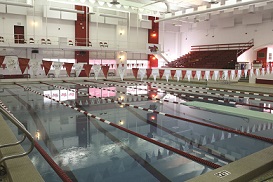
“Clovis Unified has a really good reputation with USA Swimming, so we do a lot of bids with USA Swimming,” says Andrew Smith, sports sales manager for the Fresno/Clovis Convention & Visitors Bureau, adding that the district prides itself on maintaining its facilities. “Working with Clovis Unified makes my job easy.”

